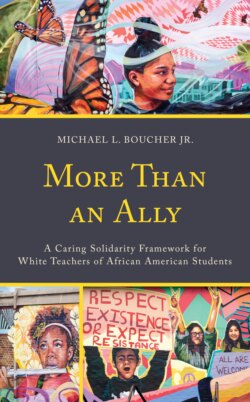Читать книгу More Than an Ally - Michael L. Boucher Jr. - Страница 20
На сайте Литреса книга снята с продажи.
Ending Color Blindness
ОглавлениеSo then, is the answer to just ignore difference and treat all kids the same? Kids are kids, right? That is the refrain stated in conversations with teachers and sometimes even in the halls of teacher preparation programs. However, research shows that kids are not all the same. Kids are individuals, but they are also members of identity groups, families, and communities. This race-evasive phrase is a way to avoid looking at students as different from their White teachers, but students are almost always different from their teachers racially, ethnically, and culturally on many levels.
Even if a teacher racially identifies as being in the same group, there will be differences based on economic status, age, and social groups, and social media has accelerated these divides and how teachers interact with students. This makes a statement like “kids are kids” one that is meant to let adults off the hook. If there is no difference in kids, then there is no need to meet the different needs of students. Bartolomé (1994) explained that this “kids are kids” approach to children’s learning has been skewed by the mentality that frames adults as whole and fully human and some kids as broken. It also seeks to erase racial and cultural differences between White kids and kids of color. It tries to rise above difference but instead enforces whiteness on everyone as though that were the cure to some kind of pernicious ailment. Because they are not broken, there is not, nor should there be, a magic method that would fix students of color. Kids are not broken, and kids of color are not broken White kids.
To sum up, as Black students will see and experience the overwhelming whiteness of teachers for most, if not all, of their schooling experience in America, to be successful, White teachers must understand their own positions as White people and of how that impacts their teaching. As Love (2019b) explained, learning about race leads to uncomfortable but crucial understandings of American history and society:
Teachers who disregard the impact of racism on Black children’s schooling experiences, resources, communities, and parent interactions will do harm to children of color. This ignorance is not just a painful sign of a blatant lack of information—a function of racism is to erase the history and contributions of people of color—it is a dangerous situation as these teachers go on to take jobs in schools filled with Black and Brown children. This turns schools into places that mirror society instead of improving it. The hard truth is that racism functions as a “superpredator” of Black and Brown children within our schools.
Until race is centered in conversations about White teachers, there can be no real progress toward a more inclusive curriculum or pedagogical framework (Sleeter, 2005). Until educators at all levels begin the project of dismantling White supremacist structures in schools and then the larger society, there will be no progress toward the multicultural goals they espouse. The current discourse of inclusion has proved insufficient to meet the challenges of today’s versions of White supremacy. More is needed and more is required from White teachers to solve the largest problems in American education.
